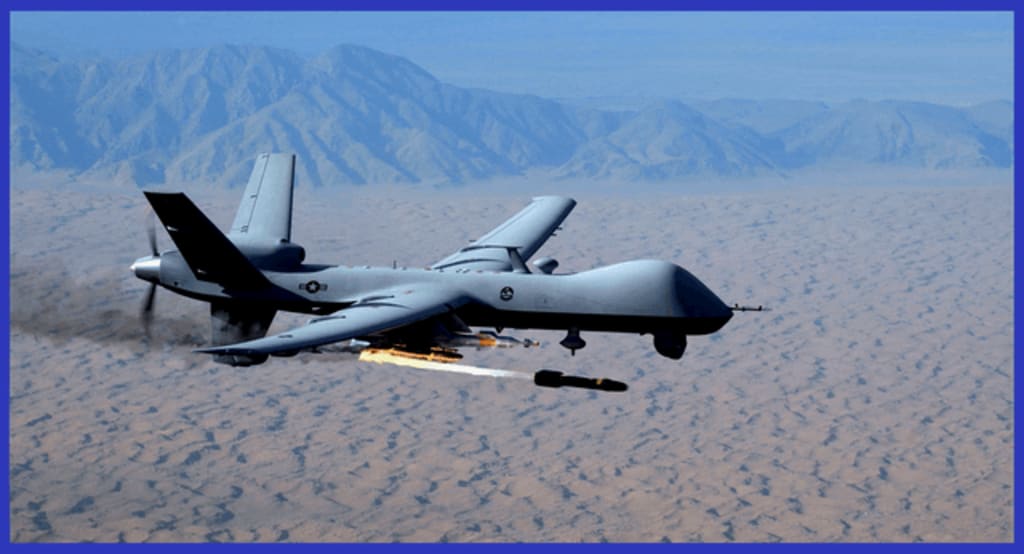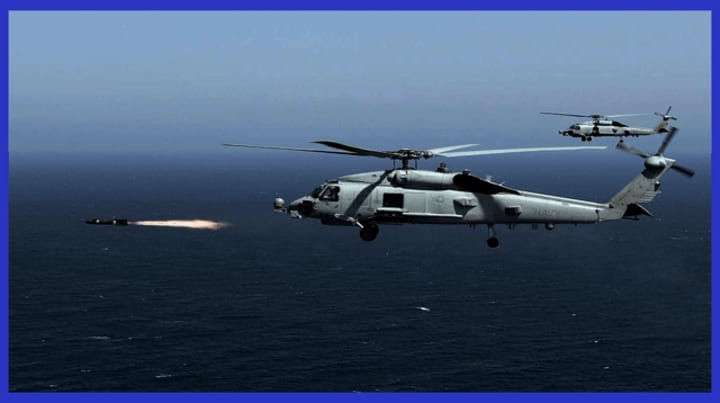AGM-114 Hellfire: The Unstoppable Force Against Armoured Vehicles
AirPra

AGM-114 Hellfire The Ultimate Anti-Armour Weapon System is purposefully designed to engage and decisively annihilate enemy armoured vehicles. Its later versions have been developed specifically for executing precision drone strikes against various target types, particularly high-value targets. This formidable weapon is predominantly employed by the United States and its esteemed allies for unparalleled air-to-surface operations. With its exceptional multi-mission, multi-target precision-strike capability, it can be launched effortlessly from a diverse range of air, sea, and ground platforms, often deployed from helicopters and unmanned aerial vehicles (UAVs). Furthermore, it has been effectively utilized on surface platforms, adeptly serving in surface-to-surface and surface-to-air roles. The complete system has been meticulously crafted and innovatively engineered to function as a fire-and-forget weapon system.
Most variants of the AGM-114 Hellfire are highly advanced and employ laser guidance for precision targeting. Among these variants, the AGM-114L "Longbow Hellfire" stands out as a radar-guided version, showcasing enhanced capabilities. The laser guidance system can be facilitated through various means, including the cutting-edge nose-mounted opto-electronics found on the formidable AH-64 Apache attack helicopter, as well as airborne target designators and ground-based observers. This versatility enables the launcher to break the line of sight with the intended target, granting it the ability to seek cover while maintaining effective guidance. Such intricate features and tactical options exemplify the sophistication and ingenuity integrated into the design of the AGM-114 Hellfire system.

The Design and Development Phase of the AGM-114 Hellfire Missile:
The design and development phase of the AGM-114 Hellfire missile can be traced back to the 1970s when the need for an advanced anti-armour weapon system was identified by the United States Army. Here are the key stages and milestones of its design and development:
Requirements and Conceptualization: The development of the Hellfire missile began with the identification of specific requirements by the U.S. Army. The initial phase of the development of the Hellfire Missile System began in 1974 in response to the United States Army's requirement for a highly effective "tank-buster" missile that could be launched from helicopters, specifically designed to defeat armoured fighting vehicles. These critical requirements encompassed not only the capacity to engage and destroy armoured targets from an aircraft but also demanded a high level of accuracy and a flexible guidance system. With these comprehensive requirements firmly in mind, a meticulous and well-thought-out conceptual design for the missile was formulated.
However, the later version of the missile came out with more additional features, which can be mentioned as smart and updated variants under the designation of 'Hellfire II'. This version started its development in the 90s and emerged as a modular missile system with several variants. It first entered service with the U.S. Army in 1996. The Hellfire II includes semi-active laser variants such as the AGM-114K high-explosive anti-tank (HEAT), AGM-114KII with an external blast fragmentation sleeve, AGM-114M with blast fragmentation capabilities, and AGM-114N with metal augmented charge (MAC). These variants achieve pinpoint accuracy by homing in on a reflected laser beam that is precisely aimed at the target.
Iterative Improvements: Throughout the design and development phase, iterative improvements were made based on test results and feedback from military users. These iterative improvements aimed to enhance the missile's accuracy, range, warhead effectiveness, and other operational characteristics. The variations of these improvements are discussed below under the corresponding heading.

Integration with Platforms: In parallel with the missile development, meticulous efforts were undertaken to ensure seamless integration of the Hellfire onto a diverse range of suitable platforms. This comprehensive endeavour involved the adaptation of the missile for effective utilization on helicopters, unmanned combat aerial vehicles (UCAVs), and A-10, ground attack aircraft.
The integration process encompassed not only the modification of the missile itself but also the development of specialized launchers, avionics interfaces, and compatible targeting systems. While the General Atomics MQ-1 Predator and MQ-9 Reaper UCAVs were specifically designed as carriers for the Hellfire II, the most frequently utilized platforms include the AH-1Z Viper, AH-64 Apache, and S-70 Black Hawk helicopter gunships, each capable of accommodating up to 16 missiles in a single sortie. Among the variants, the AGM-114L, commonly known as the Longbow Hellfire, emerges as an extraordinary fire-and-forget weapon.
Equipped with a millimetre-wave (MMW) active radar homing system, it demonstrates the exceptional capability to operate without the need for further guidance post-launch, allowing it to lock onto its designated target even after being deployed. Furthermore, the Longbow Hellfire exhibits remarkable performance in adverse weather conditions and challenging battlefield obscurants, such as smoke and fog, which have the potential to obscure the target's position or hinder the formation of a detectable reflection for laser designation.
Milestone Achievements: The development of the Hellfire missile has witnessed several remarkable accomplishments. In the year 1982, a significant breakthrough occurred with the successful deployment of the initial production version called AGM-114A. Subsequently, advanced variants known as Hellfire II, such as AGM-114K and AGM-114R, were introduced. These variants showcased notable advancements, including improved guidance systems and enhanced warheads. Of particular importance, the AGM-114R, referred to as the "Romeo" Hellfire II, became operational in late 2012, representing a significant milestone.
This variant possesses a semi-active laser homing guidance system along with a multipurpose warhead known as K-charge, enabling it to engage targets that previously necessitated multiple Hellfire variants. As a result, it effectively replaces the AGM-114K, M, N, and P variants in active service within the United States. Moreover, in their report for 2020, Lockheed Martin disclosed the delivery of an impressive quantity of 100,000 AGM-114 Hellfire missiles, reaffirming the extensive utilization and impactful role of this exceptional weapon system among both domestic and international customers.

Later-Generation Variants of the AGM-114 Hellfire Missile System:
In addition to the initial versions, several later-generation variants of the AGM-114 Hellfire missile system have been developed to enhance its capabilities and address evolving operational needs. Here are some notable later-generation variants that are currently in active use and stored in the arsenal:
AGM-114K/K2/K2A Hellfire II: The AGM-114K is an improved variant specifically designed for increased armour penetration. It has been in production from 1993 to 2018. This variant incorporates a tandem warhead configuration, consisting of a precursor charge to neutralize explosive reactive armour (ERA) and a main shaped-charge warhead to penetrate the target's armour. With its enhanced capabilities, this variant proves highly effective against heavily armoured vehicles. It boasts a range of 11 kilometres and is capable of carrying a 9-kilogram warhead while weighing a total of 45 kilograms (99 pounds).
AGM-114L Longbow Hellfire: The AGM-114L, commonly referred to as the Longbow Hellfire, incorporates a millimetre-wave radar seeker coupled with an inertial guidance system. This dual-mode guidance enables the missile to effectively engage targets in adverse weather conditions, penetrate smoke, provide the beyond-line-of-sight capability, and effectively target moving objects. It offers an advanced fire-and-forget capability, significantly enhancing operational flexibility.
The AGM-114L was produced from 1995 to 2016 and is currently in sustainment. It boasts a range of 8 kilometres when targeting armoured vehicles. The missile weighs 49 kilograms and features a 9-kilogram (20-pound) tandem shaped-charge high-explosive anti-tank (HEAT) warhead, equipped with insensitive munitions (IM) technology. Additionally, the warhead is equipped with a proximity fuze and a blast-fragmentation sleeve to maximize the effectiveness of detonation.

AGM-114M Hellfire II (Blast Frag): The AGM-114M Hellfire is an upgraded variant that combines the capabilities of the AGM-114K and AGM-114L. It incorporates a tandem warhead to enhance armour penetration and utilizes a dual-mode guidance system, enabling it to engage targets effectively in all weather conditions. The AGM-114M became the standard variant for the U.S. Army and numerous international customers.
The AGM-114M Hellfire is specifically designed to target light bunkers, light vehicles, urban (soft) targets, and caves, and it is primarily utilized by Unmanned Combat Aerial Vehicles (UCAVs). It was produced between 1998 and 2010, offering a range of 11 kilometres. The missile itself weighs 49 kilograms(108 pounds), including the blast fragmentation/incendiary warhead that weighs 9 kilograms.
AGM-114N Hellfire, MAC (Metal Augmented Charge): The AGM-114N Hellfire II MAC is an advanced variant optimized for urban warfare, Buildings, soft-skinned targets, ship-borne targets and asymmetric threats. It incorporates insensitive munitions (IM) technology, reducing the risk of accidental detonation. This variant maintains the tandem warhead ( Metal augmented charge, sustained pressure wave with delayed fuse capability ) configuration for enhanced armour penetration and is compatible with multiple launch platforms.
It was Produced from 2003–2018, Has a range of 11 km, with dual mode of guidance ( Semi-active laser homing and Millimeter-wave radar seeker) Has a weight of 48 kilograms(106 pounds )
AGM-114R Hellfire II (Romeo): The AGM-114R is a highly versatile variant that incorporates a reduced net explosive weight multi-purpose warhead, ensuring minimal collateral damage during engagements. It offers the capability to switch between two selectable fuzing modes, namely the blast fragmentation mode, which proves effective against soft targets and personnel, and the shaped-charge mode, optimized for engaging various target types. This flexibility allows the missile to effectively engage a wide range of targets, catering to different operational requirements.
The AGM-114R Hellfire II (Romeo) represents the latest variant in the Hellfire series, with production commencing in 2012. It boasts a range of 11 kilometres and utilizes a semi-active laser homing guidance system, enabling precise target tracking and engagement. The missile has a total weight of 49 kilograms (108 pounds), which includes a 9-kilogram (20-pound) warhead, further enhancing its destructive capabilities.

AGM-114P/P+ Hellfire II (For UAS): The AGM-114P/P+ is a specialized variant of the Hellfire II missile designed specifically for Unmanned Aircraft Systems (UAS). It provides UAS platforms with a highly effective precision strike capability, enabling them to engage a variety of targets on the battlefield.
This variant's capabilities make it a valuable asset for UAS operators, allowing them to conduct surveillance, reconnaissance, and offensive missions with increased accuracy and effectiveness. Produced from 2003 to 2012, the AGM-114P/P+ has a range of 11 km and utilizes semi-active laser homing guidance. It is equipped with delayed and programmable fusing, enhancing its effectiveness against hardened targets. The missile has a weight of 49 kg (108 lb) and features a shaped charge or blast fragmentation warhead.
AGM-114P/P+ Hellfire II (For UAS): The AGM-114P/P+ is a specialized variant of the Hellfire II missile designed specifically for Unmanned Aircraft Systems (UAS). It provides UAS platforms with a highly effective precision strike capability, enabling them to engage a variety of targets on the battlefield.
This variant's capabilities make it a valuable asset for UAS operators, allowing them to conduct surveillance, reconnaissance, and offensive missions with increased accuracy and effectiveness. Produced from 2003 to 2012, the AGM-114P/P+ has a range of 11 km and utilizes semi-active laser homing guidance. It is equipped with delayed and programmable fusing, enhancing its effectiveness against hardened targets. The missile has a weight of 49 kg (108 lb) and features a shaped charge or blast fragmentation warhead.

AGM-114R9X (Missile with 6 Sharp Blades): The Hellfire R9X is a variant of the Hellfire missile that features a kinetic warhead with pop-out blades instead of explosives. It is specifically designed for use against targeted individuals. The effectiveness of this variant lies in its utilization of a dense material weighing 45 kg (99 lb) and six high-speed blades, which are deployed to crush and cut the intended target. Due to its unique characteristics, the R9X has earned the nickname "Ninja Missile."
The primary purpose of the AGM-114R9X is to minimize collateral damage during surgical strike missions that specifically target individuals. Although it was secretly deployed in 2017, its existence became public knowledge in 2019. This missile is included in the munitions inventory of the US Special Operations Command.
These later-generation variants demonstrate the continuous improvement and adaptation of the AGM-114 Hellfire missile system to meet evolving operational requirements. The variants offer increased armour penetration, all-weather capabilities, enhanced flexibility, and optimized performance for specific mission scenarios.

Operational History of the AGM-114 Hellfire Missile:
The AGM-114 Hellfire missile has a rich operational history and has been employed in various conflicts and military operations worldwide.
Gulf War (1990-1991): The Hellfire missile saw its first major combat deployment during the Gulf War. It was employed extensively by U.S. Army Apache attack helicopters and OH-58D Kiowa Warrior scout helicopters against Iraqi armoured targets, bunkers, and fortified positions. The Hellfire played a significant role in disabling and destroying Iraqi armoured vehicles, contributing to the success of coalition forces.
Balkans Conflict (1990s): The Hellfire missile was utilized by NATO forces during the conflicts in the Balkans, particularly in operations such as the Kosovo War and the Bosnian War.
Drone Strikes: The Hellfire missile has become closely associated with unmanned aerial vehicles (UAVs) or drones. It has been utilized by the U.S. military and intelligence agencies in targeted drone strikes against terrorist organizations and high-profile individuals in regions such as Pakistan, Yemen, Syria, Afghanistan, and Somalia. Its precision and lethality make it an effective tool for counterterrorism operations. One distinctive drone strike involved the use of a unique version of the AGM-114R9X Ninja missile. This missile was employed in the 2017 killing of Abu Khayr al-Masri, a member of Al-Qaeda's leadership, and in the 2019 elimination of Jamal Ahmad Mohammad Al-Badawi, the accused mastermind of the 2000 USS Cole bombing.
Counterinsurgency Operations: The Hellfire missile has demonstrated its effectiveness in counterinsurgency operations by successfully neutralizing threats posed by armed groups and insurgents. Its utilization in various conflicts, such as the Iraq War and the War in Afghanistan, has proven to be instrumental in targeting insurgents and their hideouts, resulting in the reduction of their capabilities and the disruption of their activities.
Noteworthy operations involving Hellfire missiles include the targeted killing of Hamas leader Ahmed Yassin by the Israeli Air Force (IAF) in 2004. The US military also employed these missiles to eliminate Anwar al-Awlaki, an American-born Islamic cleric, in Yemen in 2011; Abu Yahya al-Libi, an Al-Qaeda operative, in Pakistan in 2012; Mukhtar Abu Zubair, an al-Shabaab militant, in Somalia in 2014; and Mohammed Emwazi, a British ISIL executioner also known as "Jihadi John," in Syria in 2015. All of these operations were conducted by Unmanned Combat Aerial Vehicles (UCAVs).
The AGM-114 Hellfire missile's operational history spans several decades, and its effectiveness and reliability have made it a preferred choice for engaging armoured targets, fortified positions, and high-value threats in a wide range of military operations around the world.

Technical Specifications Of The AGM-114 Hellfire Missile:
Weight: 45–49 kg ( 100-108 lb ) based on variants
Length: 64 in ( 1.6 m )
Diameter: 7 in ( 180 mm )
Wingspan: 13 inches
Warhead: High-explosive anti-tank / Shaped charge / Tandem-charge anti-armour / Metal augmented charge / High-explosive anti-tank / Shaped charge / Tandem-charge anti-armour / Metal augmented charge / Blast fragmentation warhead weighing 9 kg (20 lb), based on variants
Detonation: Various impact fuze options
Engine: Solid propellant rocket motor
Propellant: Solid propellant
Range: 11 km
Speed: Mach 1.3 ( 995 mph )
Guidance system: Semi-active laser homing and Millimeter-wave radar seeker
Launch Platform: Helicopter ( AH-1Z Viper, AH-64 Apache, and S-70 Black Hawk helicopter), Aircraft ( KC-130 Hercules ), UCAV ( MQ-1 Predator, MQ-9 Reaper, Protector RG Mk1, MQ-9B SeaGuardian ), Ground vehicles ( Stryker ), Petrol boats and combat Ships

In conclusion, the AGM-114 Hellfire missile is a highly effective and versatile anti-armour weapon system with a significant operational history. Its precision, lethality, and adaptability have made it a preferred choice for engaging armoured targets and high-value threats in various conflicts and counterterrorism operations. The Hellfire's design and development phase led to iterative improvements and the creation of later-generation variants that enhanced its capabilities. From the Gulf War to the present day, it has been utilized by armed forces worldwide, contributing to successful missions and demonstrating its operational effectiveness. The Hellfire's association with UAVs and its use in targeted drone strikes have further expanded its operational utility. Overall, the Hellfire missile system remains a crucial asset in modern warfare.
About the Creator
Prajesh Majumdar
Hi there, I'm Prajesh, the creator of airpra.com
The site is dedicated to nurturing a community of individuals with a keen interest in exploring the intricate aspects of defence equipment and related news.






Comments
There are no comments for this story
Be the first to respond and start the conversation.